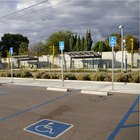Even though assisted living is a very specific term, it is often inaccurately applied to a host of other programs, including supportive living. Both programs provide supportive environments to build individual self-esteem, maintain dignity and ensure independence. However, each program provides different services to meet the needs of their target groups. If you’re considering one of these programs for yourself or a loved one, you should become familiar with the services provided to make an informed decision.
Assisted Living Programs
Assisted living facilities typically serve the elderly. Their main focus is providing an environment in which the individual can continue to live her day-to-day life while maintaining a sense of security. Assisted living facilities can be apartments, individual homes or a combination of both.
Assisted Living Services
Rather than structuring the lives of the residents, as done in nursing homes or extended-care facilities, assisted living facilities provide only the services the resident needs. Some residents may need food purchased and prepared for them, while others prefer to do these things on their own. Many facilities offer services for health care, including on-site nurses or complete ambulatory centers.
Supportive Living Programs
While assisted living targets the elderly, supportive living focuses on adults with developmental disabilities. Persons in supportive living require help structuring their lives, finding housemates or managing their finances. Supportive living is accomplished through individual housing, group homes or apartments.
Supportive Living Services
In supportive living, the focus is on teaching the individual how to live independently through structured support. Counselors are available to each member of the program to help complete daily tasks, which the member may be unable to complete on his own. The services provided are always individually oriented, to encourage independence, so counselors provide only as much involvement as the member wants and needs.
Goals of the Services
The main difference between assisted living and supportive living is the end goal. Assisted living aims to empower the elderly or disabled to live on their own for as long as possible. It fills in the gaps the resident faces as she grows older or her disease progresses. As he needs more help, the assisted living facility steps in to provide the service or, if he is unable to care for himself, he is moved to a nursing home. Supportive living, on the other hand, teaches developmentally delayed adults how to live on their own. Rather than adding services as needed, the goal is to guide the individual so she no longer requires as many, or any, services.
Related Articles

Qualifications to Enter a State-Run ...

How to Care for the Disabled

Programs to Take Care of a Disabled ...

How to Get Rental Assistance for Seniors

Goals and Objectives of Senior Care ...

How to Get Paid to Care for Someone on ...

What Is Emotional Compatibility?

How to Write Grants for Churches

Indiana Child Daycare Laws

Similarities and Differences Between ...

How to Get Senior Low Income Housing ...

What Is Transitional Housing?

How to Get Paid to Care for a Relative

Government Funding for Taking Care of ...

How to Get Paid for Caring for Your ...

How to Get Paid to Stay Home & Care for ...

Who Gives Donated Vehicles to the Poor?

How to Admit Someone to a Nursing Home

Ways to Keep Church Membership Records ...

How to End a Toxic Relationship With ...
References
Resources
Writer Bio
Rebecca O'Brien has been writing since 2006. She contributes to several online magazines, specializing in politics, technology, parenting and cuisine. She studied marketing and language arts at McHenry County College.